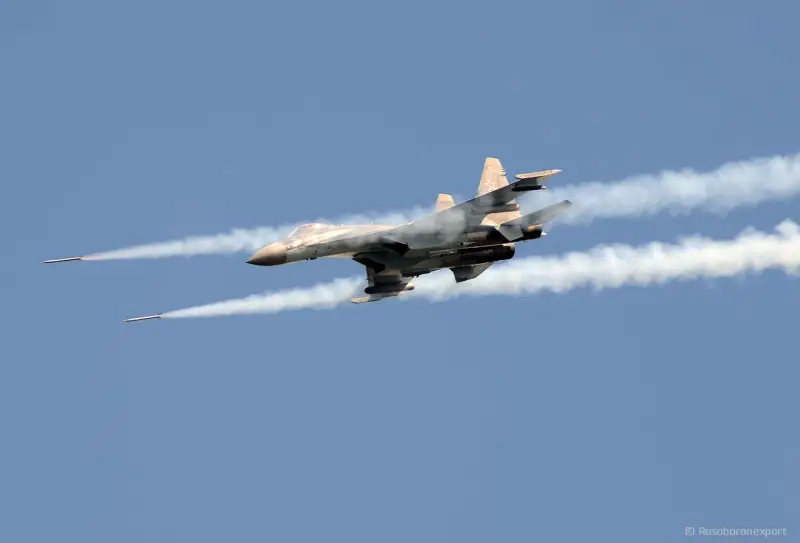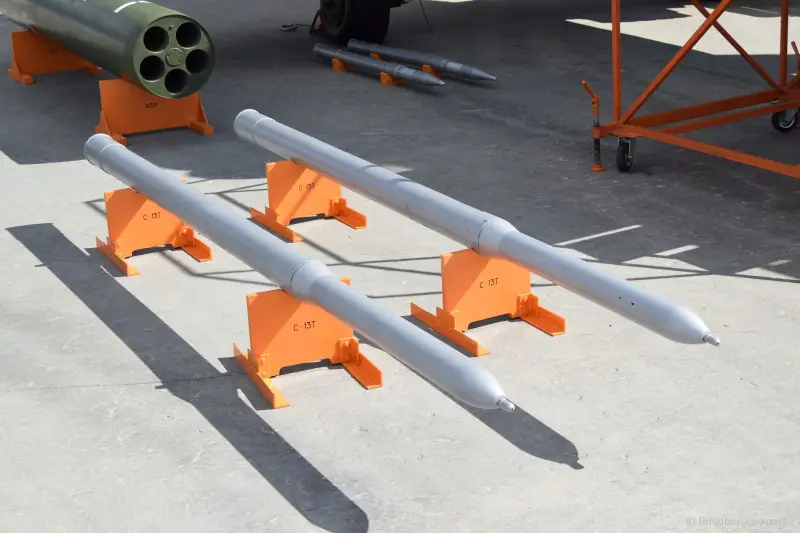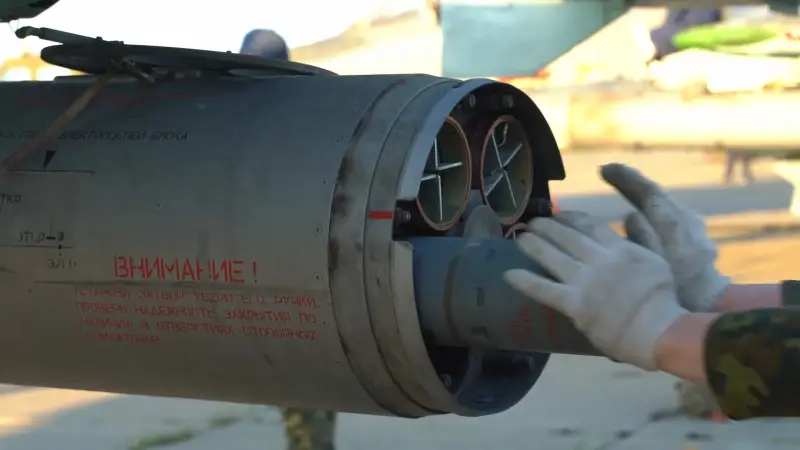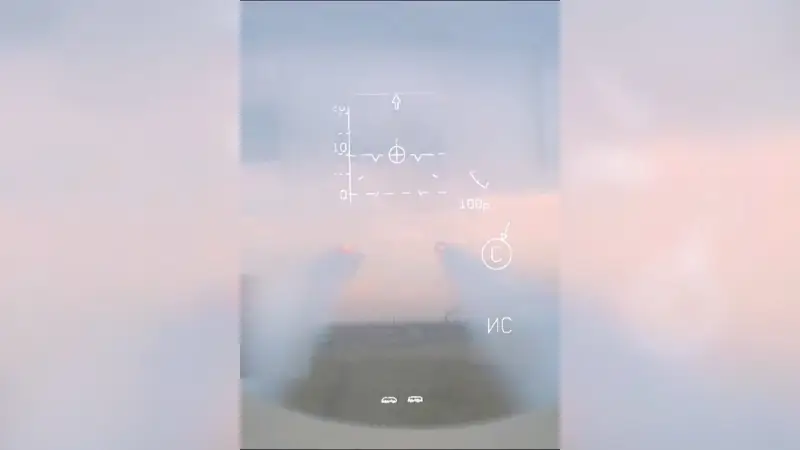Unguided missiles S-13 "Tulumbas" in operation and in combat

The fighter uses S-13 missiles
Russian front and army aviation uses a variety of weapons in the current Special Operation, incl. unguided rockets. A prominent place in its arsenals is occupied by S-13 Tulumbas rockets. This missile was put into service ca. 40 years ago, and then on its basis they created a whole family of products with different capabilities and parameters. Despite its advanced age, the S-13 line remains effective and convenient weapons. Several main factors contribute to maintaining this state of affairs.
"Air-ground"
As far as we know, S-13 unguided aircraft missiles (UAR) have been used in the Special Operation to protect Donbass almost from its very beginning. With their help, Su-25 attack aircraft, as well as Ka-52 and Mi-28 attack helicopters, attack a variety of targets and objects. Enemy positions and concentrations, equipment and fortifications come under missile attack. In this case, missiles of different modifications are used with different warheads, optimized to hit certain targets.
The Ministry of Defense has repeatedly demonstrated footage of the combat use of unguided missiles, incl. "Tulumbasov". Depending on the task at hand and the situation at the site, launches of the unmanned aerial vehicle are carried out from a flat dive or from a nose-up. Launches are carried out from a distance of up to several kilometers, taking into account the requirements of a specific modification of the weapon.
Like any unguided weapon, the S-13 family of unguided missiles have limitations in terms of shooting accuracy. However, modern fire control devices for aircraft and helicopters make it possible to improve such indicators regardless of the flight mode. In addition, the ability to fire in one gulp is important. At the same time, a certain dispersion of projectiles is necessary for working against area targets and makes it possible to hit a specific object with a greater probability.

S-13T missiles with tandem warhead and extended warhead
In general, S-13 products remain a simple and inexpensive aircraft weapon capable of effectively hitting designated targets. They are used within the same weapon system with rockets of other calibers and occupy an intermediate position between the lighter S-8 NAR and the heavy S-24 and S-25.
Progressive development
At the turn of the sixties and seventies, the Ministry of Defense came to the conclusion that it was necessary to create a promising NAR capable of penetrating concrete shelters and hitting equipment and manpower inside them. After the necessary preliminary studies, in 1973 this idea was brought to the development stage. The creation of a project with the code “Tulumbas” (a type of percussion musical instrument) was entrusted to the Institute of Applied Physics (Novosibirsk).
Taking into account the technical task set and the specifics of the existing NAR nomenclature, the rocket caliber was chosen as 122 mm or 12,2 cm, from which the S-13 index was formed, rounded up. The first version of the missile received concrete-piercing combat equipment to destroy protected objects and materiel inside them. The development of such a missile and the “gun array” for it continued until the end of the decade. In 1979, the S-13 missile with the UB-13 launch unit was presented for state testing. Due to the specific combat mission, testing and modification of the missile lasted several years. It was only in 1983 that the S-13 product was put into service.
By this time, the development of new modifications of the NAR had begun. As a result of this process, the improved S-1984T penetrating missile was adopted in 13. In 1986, the Air Force began to receive the S-13OF NAR with a high-explosive fragmentation warhead, and in the early nineties they developed the S-13D with volumetric detonating equipment. Some of these products were subsequently modernized using new components and technologies.

Preparing the UB-13 unit for a combat mission as part of the Special Operation, 2022.
Design features
All missiles of the S-13 “Tulumbas” family have a similar design, but differ from each other in certain features. The differences are due to the need to solve different combat missions and/or differences in tactical and technical characteristics. Moreover, all modifications of the NAR can be used with a single block of guides and on all compatible carriers.
S-13 missiles are manufactured in an elongated cylindrical body of uniform or variable diameter. The warhead is placed in the head compartment of the hull, and the main volume is given over to the solid propellant engine. The tail has a section of reduced diameter, to which folding stabilizers are attached, giving the rocket rotation in flight.
The size and weight of the products changed as the family developed. Thus, the basic NAR S-13 received a bicaliber body with a diameter of 90 mm in the head section with a 122 mm engine compartment. The total length reached 2,54 m with a weight of 57 kg. The next S-13T also had a bicaliber body, but was longer and heavier - 3,1 m and 57 kg. High-explosive fragmentation and volume-detonating combat equipment is placed in the head compartment of 122 mm caliber. Missiles with such warheads were no larger or heavier than the S-13T.
The basic S-13 received a penetrating warhead weighing 21 kg with an explosive charge of 1,82 kg, capable of penetrating up to 3 m of soil and 1 m of concrete, and then exploding behind an obstacle. For the S-13T, a tandem penetrating warhead was developed, in which the existing charge was supplemented with a new one weighing 16,3 kg. Penetration capacity has improved to 6 m of soil and 1 m of concrete. High-explosive fragmentation missiles received warheads weighing up to 33-38 kg with an explosive charge of 7-15,5 kg. Volumetric detonating warheads for the S-13D/DF have a mass of 32-33 kg.

Launch of an S-13 missile by a Su-25 attack aircraft
Using the standard engine, the NAR S-13 accelerates to 650 m/s. The initial speed of heavier missiles of the family was reduced to 500-530 m/s. The launch range is up to 3 km for early modifications and up to 5-6 km for later modifications.
The secret of longevity
The NAR S-13 “Tulumbas” has been in service for 40 years and is constantly evolving. These missiles are actively used in training events and in real military operations, and the Aerospace Forces are not going to abandon them. It can be expected that different versions of the S-13, incl. completely new developments will continue to be in service in the next decades. This longevity of an unguided rocket is due to several main factors.
First of all, it is the simplicity of the design. An unguided rocket lacks complex equipment and is easy to manufacture. The low cost makes it possible to produce missiles in large quantities and create warehouse stocks of the required volume. Accordingly, combat aviation gets the opportunity to actively use missiles and solve problems without worrying about the consumption of ammunition and the economic component of airstrikes.
Despite the simplicity of the architecture, all versions of the S-13 are built on successful units and show high tactical and technical characteristics for their class. A sufficiently high firing range and the power of combat units are ensured. In addition, the simple architecture facilitates modernization, which can only be accomplished by replacing the main components - the engine and warhead.

Firing from a pitch-up position, view from the pilot's seat
For the S-13 family, combat units of three main classes with different functions and combat capabilities have been created. This significantly improves the flexibility of the combat operation of missile carriers and allows them to attack a variety of targets, from manpower to field fortifications and shelters.
The absence of special controls to a certain extent simplifies the integration of NAR into the weapons complex of a particular carrier. At the same time, to increase the accuracy of firing unguided missiles, appropriate fire control systems and/or software for them are needed. Thanks to this, all current aircraft and helicopters of front-line and army aviation can use the S-13 and other missiles, and we can expect that promising models of the next generations will retain this capability.
In terms of its tactical and technical characteristics, Tulumbas occupies an intermediate position between lighter and heavier domestically produced missiles. It becomes possible to choose ammunition that more fully corresponds to the task at hand and the existing conditions. Accordingly, the flexibility of using unguided missile weapons in general increases.
Operation continues
Thus, S-13 unguided missiles remain in service with our Aerospace Forces and retain their status as one of the most popular models. Despite its advanced age, this family of missiles is actively used in various combat missions and is used against a variety of enemy targets.
Right now you can observe the results of the combined use of modern aircraft with advanced control systems and unguided missiles. The demilitarization of the Kyiv regime is successfully moving forward, and Tulumbas of various modifications are making a certain contribution to this.
Information